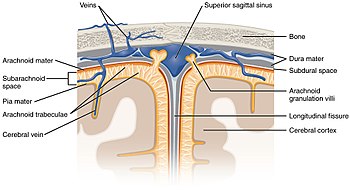Meninges
This article needs additional citations for verification. (June 2014) |
| Meninges | |
|---|---|
nervus spinosus | |
| Identifiers | |
| Latin | meninges |
| MeSH | D008578 |
| TA98 | A14.1.01.001 |
| TA2 | 5369 |
| FMA | 231572 |
| Anatomical terminology] | |
In
Structure
Dura mater
The dura mater (
The dura has four areas of infolding:
- Falx cerebri, the largest, sickle-shaped; separates the cerebral hemispheres. Starts from the frontal crest of frontal bone and the crista galli running to the internal occipital protuberance.
- Tentorium cerebelli, the second largest, crescent-shaped; separates the occipital lobes from cerebellum. The falx cerebri attaches to it giving a tentlike appearance.
- Falx cerebelli, vertical infolding; lies inferior to the tentorium cerebelli, separating the cerebellar hemispheres.
- Diaphragma sellae, smallest infolding; covers the pituitary gland and sella turcica.

Arachnoid mater

The middle element of the meninges is the arachnoid mater, or arachnoid membrane, so named because of its resemblance to a spider web. It cushions the central nervous system. This thin, transparent membrane is composed of fibrous tissue and, like the pia mater, has an outer layer of tightly packed flat cells, forming the arachnoid barrier.[8]
The shape of the arachnoid does not follow the convolutions of the surface of the brain and so looks like a loosely fitting sac. In particular, in the region of the brain a large number of fine filaments called arachnoid trabeculae pass from the arachnoid through the subarachnoid space to blend with the tissue of the pia mater. The arachnoid barrier has no extracellular collagen and is considered to represent an effective morphological and physiological meningeal barrier between the cerebrospinal fluid in the subarachnoid space and the blood circulation in the dura.
The arachnoid barrier layer is characterized by a distinct continuous basal lamina on its inner surface toward the innermost collagenous portion of the arachnoid reticular layer.
Pia mater
The pia mater (Latin: tender mother)
Subarachnoidal lymphatic-like membrane
The subarachnoid lymphatic-like membrane (SLYM) is a recently described anatomical structure in the human brain that was proposed in 2023 as a possible fourth layer of the meninges.[10]
The SLYM is located in theLeptomeninges
The
Subarachnoid space

The subarachnoid space is the space that normally exists between the
The dura mater is attached to the
Clinical significance
Injuries involving the meninges, can result in a
- A subarachnoid hemorrhage is acute bleeding under the arachnoid; it may occur spontaneously or as a result of trauma.[15]
- A arachnoidare torn, usually during an accident, and blood leaks into this area.
- An epidural hematoma, bleeding between the dura mater and the skull, may arise after an accident or spontaneously.
Other medical conditions that affect the meninges include
Other animals
In
Mammals (as higher vertebrates) retain the dura mater, and the secondary meninx divides into the arachnoid and pia mater.[17]
Additional images
-
Illustration of the work by Antonio Pacchioni Disquisitio anatomicae de durae meningis ... published in Acta Eruditorum, 1703
See also
Notes
- ^ Also rarely called meninx fibrosa or pachymeninx
References
- ^ "meninges". Oxford Learner's Dictionaries.
- ^ "Definition of meninges". Merriam-Webster Online Dictionary. Retrieved 28 July 2012.
- ^ "Definition of meninx". Merriam-Webster Online Dictionary. Retrieved 28 July 2012.
- Perseus Project
- ^ Castillero Mimenza, Oscar (January 2017). "Meninges: anatomía, partes y funciones en el cerebro".
- ^ "Definition of dura mater". Merriam-Webster Online Dictionary. Retrieved 22 June 2022.
- ^ "Scalp Anatomy: Structure, Nerve Supply, Arterial Supply". 20 June 2017.
- S2CID 14753395.
- ^ "Definition of pia mater". Merriam-Webster Online Dictionary. Retrieved 27 November 2015.
- ^ S2CID 255440992.
- ^ "leptomeninges". Oxford Dictionaries | English. Archived from the original on November 4, 2016.
- OCLC 892583347.
In acute meningitis, an exudate is evident within the leptomeninges over the surface of the brain (Fig. 28-21).
- S2CID 15404074.
- ^ "Overview of Adult Traumatic Brain Injuries" (PDF). Orlando Regional Healthcare, Education and Development. 2004. Archived from the original (PDF) on February 27, 2008.
- S2CID 29126514.
- ^ ISBN 9780125296502.
- ISBN 0-697-21991-7.
External links
 Media related to Meninges at Wikimedia Commons
Media related to Meninges at Wikimedia Commons

